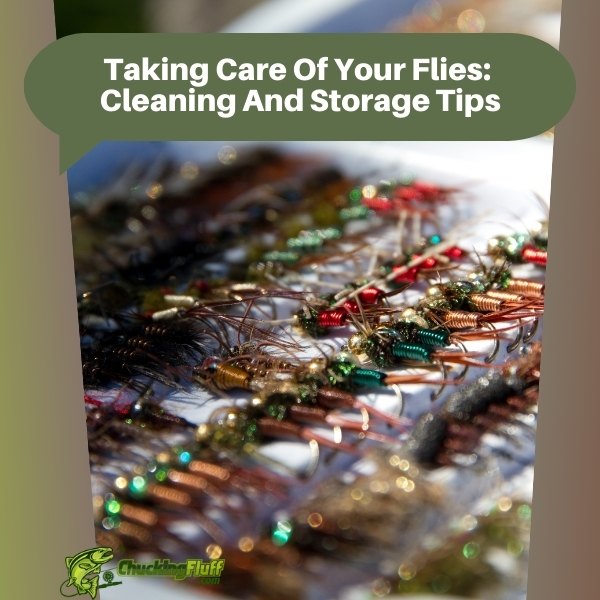| Disclosure: Just to be open and honest the buttons and links you click on in the website will in most cases take you to another website where you can purchase the products I am reviewing. As an Amazon Associate I earn from qualifying purchases. |
Taking Care Of Your Flies: Cleaning And Storage Tips

Fishing is an art form, and one of the most important tools in your tackle box is your collection of flies. Whether you’re casting a delicate dry fly or a weighted nymph, each fly plays a key role in your success on the water. But here’s the kicker: flies are not a one-time-use item! They require proper care to maintain their shape, effectiveness, and longevity. So, how do you ensure your flies stay in top condition? This guide will walk you through everything you need to know about cleaning, storing, and maintaining your flies.
Quick Post Navigation
- Introduction to Fly Care
- Why Fly Maintenance Is Important
- Understanding the Anatomy of a Fly
- Types of Fishing Flies
- Tools You’ll Need for Cleaning Flies
- How Often Should You Clean Your Flies?
- The Step-by-Step Process of Cleaning Your Flies
- How to Properly Store Your Flies
- The Impact of Weather and Environment on Fly Care
- How to Identify a Worn-Out Fly
- Repairing vs. Replacing Flies
- Long-Term Storage for Seasonal Flies
- Common Mistakes to Avoid in Fly Care
- Pro Tips for Extending the Life of Your Flies
- Eco-Friendly Ways to Dispose of Old Flies
- Conclusion
- FAQs
- “Check out some of our other Buying Guides”
Introduction to Fly Care
When it comes to fishing flies, a little maintenance goes a long way. Whether you’re a seasoned angler or just getting started, taking care of your flies is crucial to keep them in tip-top shape for future fishing trips. Think of your flies as a well-worn pair of hiking boots—if you don’t clean and store them properly, they won’t perform well when you need them most.
Why Fly Maintenance Is Important
Neglecting your flies can lead to a multitude of problems: they can become tangled, damaged, or even lose their effectiveness in the water. By regularly cleaning and properly storing your flies, you ensure they remain functional, last longer, and continue to attract fish like they’re supposed to.
Understanding the Anatomy of a Fly
Before we dive into the cleaning and storage process, it’s important to understand the anatomy of a fly. Each fishing fly consists of various components—hooks, threads, feathers, and synthetic materials. These components are delicate and can wear down over time, so knowing what to look for helps when it’s time to give them a little TLC.
Types of Fishing Flies
Different flies require different levels of care, and it all starts with understanding the type of fly you’re using.
Dry Flies
These are designed to float on the water surface and imitate insects. Because they’re light and delicate, dry flies can lose their buoyancy if not cared for properly.
Wet Flies
Wet flies are designed to sink just below the surface, and because they’re often exposed to more water, they’re more prone to damage and wear.
Streamers
Streamers imitate small baitfish or other aquatic creatures. These are bulkier and require a bit more attention when cleaning due to the use of more materials.
Nymphs
Nymphs are designed to sink to the bottom and imitate the larval stage of insects. Because they’re often dragged along the riverbed, they can get dirtier than other flies.
Tools You’ll Need for Cleaning Flies
Let’s talk tools. Cleaning your flies doesn’t require anything fancy, but there are a few basics that will make the process easier:
- Soft-bristled brush
- Bowl of warm water
- Mild soap (nothing too harsh that could damage materials)
- Paper towels or microfiber cloths for drying
- Toothpicks or small tweezers for delicate areas
These items are your new best friends when it comes to fly maintenance.
How Often Should You Clean Your Flies?
How often should you clean your flies? This depends on how frequently you fish and the type of waters you fish in. If you’re fishing in clear water, you might get away with cleaning your flies less often. But if you’re in murky, muddy waters, cleaning after every trip is essential. Think of it like washing your car—it depends on where you’ve been driving!
The Step-by-Step Process of Cleaning Your Flies
Now, let’s get into the nitty-gritty of cleaning your flies.
Preparing the Cleaning Area
Find a clean, flat space where you can comfortably lay out your flies. This could be a countertop or even a sturdy table. Lay down some paper towels to absorb any excess water.
Cleaning with Water and Gentle Soap
Gently dip your fly into a bowl of warm water mixed with a tiny amount of mild soap. Use a soft-bristled brush to lightly scrub the materials, being careful not to damage the feathers or synthetic fibers. Avoid soaking the fly for too long, as too much water can weaken the materials.
Drying Your Flies Properly
Once cleaned, gently pat the fly dry with a microfiber cloth or paper towel. It’s important to let them air dry fully before storing them away. You can even use a hairdryer on a low setting to speed up the process, but be cautious not to overheat the materials.
How to Properly Store Your Flies
After you’ve cleaned your flies, proper storage is the next step in ensuring they last for many fishing seasons to come.
Storing Flies in Boxes
Fly boxes are designed to keep your flies organized and safe. Invest in a good quality fly box with compartments for different types of flies. If you fish in various environments, having separate boxes for different conditions can be a game changer.
Organizing Flies by Type
Organization is key. You don’t want to be rifling through a box full of tangled flies when a trout rises in front of you. Store your dry flies in one section, wet flies in another, and so on. This makes it easy to find the right fly at the right time.
Keeping Flies Dry During Storage
Moisture is your enemy when storing flies. Make sure your flies are completely dry before putting them into your fly box. You can even place small silica gel packets inside the box to absorb any excess moisture.
The Impact of Weather and Environment on Fly Care
Flies, much like us, are affected by their environment. Humidity, heat, and even cold can all have negative effects on the materials used in your flies. If you’re fishing in high-humidity areas, you may need to take extra precautions to ensure your flies don’t become waterlogged or moldy.
How to Identify a Worn-Out Fly
How do you know when it’s time to retire a fly? The main signs include frayed threads, missing or damaged feathers, and rust on the hook. A fly that’s falling apart won’t be as effective, and it may spook fish instead of attracting them.
Repairing vs. Replacing Flies
Some flies are worth saving, while others might be beyond repair. If a fly is only slightly damaged, consider repairing it with fresh materials. But if the hook is rusty or the fly is completely mangled, it’s time to say goodbye and replace it.
Long-Term Storage for Seasonal Flies
If you have flies that you only use during specific seasons, long-term storage is essential. Store these flies in a cool, dry place, and make sure they’re organized so you don’t forget what’s what when the season comes around again.
Common Mistakes to Avoid in Fly Care
We’ve all been there—accidentally leaving flies in a damp pocket or cramming them into a tackle box without a second thought. Avoid these common mistakes by always cleaning, drying, and storing your flies properly.
Pro Tips for Extending the Life of Your Flies
- Always rinse your flies with clean water after a trip to saltwater.
- Use a toothbrush to gently fluff up the fibers of a dry fly after it’s been used.
- Rotate your flies regularly to ensure they all get some time on the water.
Eco-Friendly Ways to Dispose of Old Flies
When your flies have reached the end of their life, don’t just toss them into the trash. Many of the materials can harm the environment. Consider recycling parts of the fly or disposing of them in a way that won’t negatively impact the environment.
Conclusion
Taking care of your flies is like taking care of your favorite tools—you’ll get more mileage out of them, and they’ll perform better when you need them most. Whether it’s a quick cleaning after a fishing trip or a full storage overhaul, a little effort goes a long way. Keep your flies organized, clean, and ready for action, and they’ll reward you with many successful fishing trips.
FAQs
How do I clean a fly without damaging it?
The best way to clean a fly is to gently rinse it in warm water with a tiny bit of mild soap. Use a soft brush to remove dirt and debris, and always let it air dry completely before storing it away.
How long can fishing flies last with proper care?
With proper cleaning and storage, a well-made fishing fly can last for several years. However, this depends on how often you fish and the environments you fish in.
Can I use the same cleaning methods for all types of flies?
Yes, the general cleaning process is the same for most flies. However, delicate flies like dry flies require extra care during cleaning to preserve their buoyancy.
What should I do if my fly gets damaged while fishing?
If your fly gets damaged while fishing, assess the extent of the damage. Minor frays can be fixed, but if the hook is rusted or bent, it’s best to replace the fly.
How do I keep my flies dry while on the water?
To keep your flies dry on the water, use a fly box with proper ventilation. Also, avoid leaving wet flies in your vest pockets for long periods.


